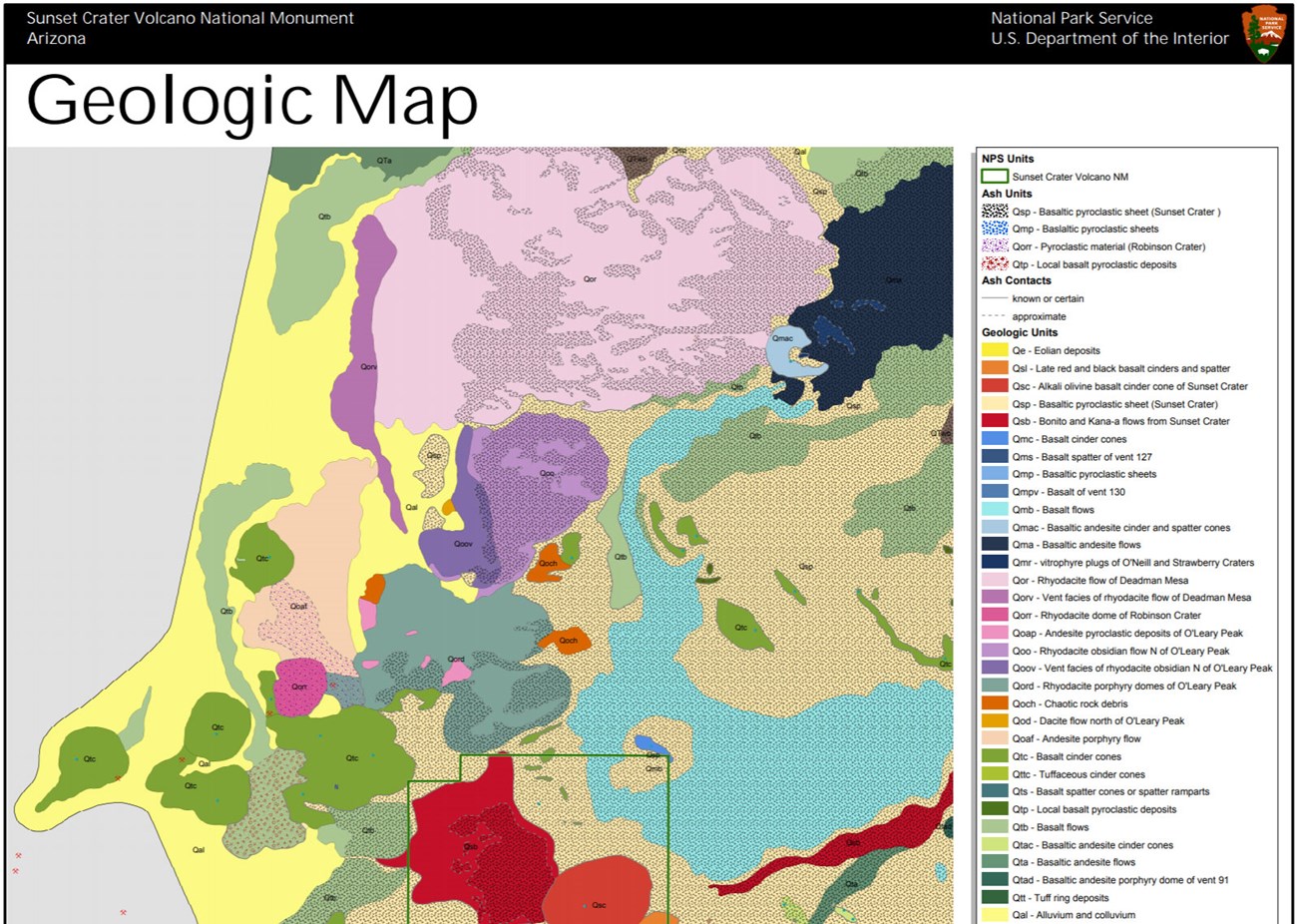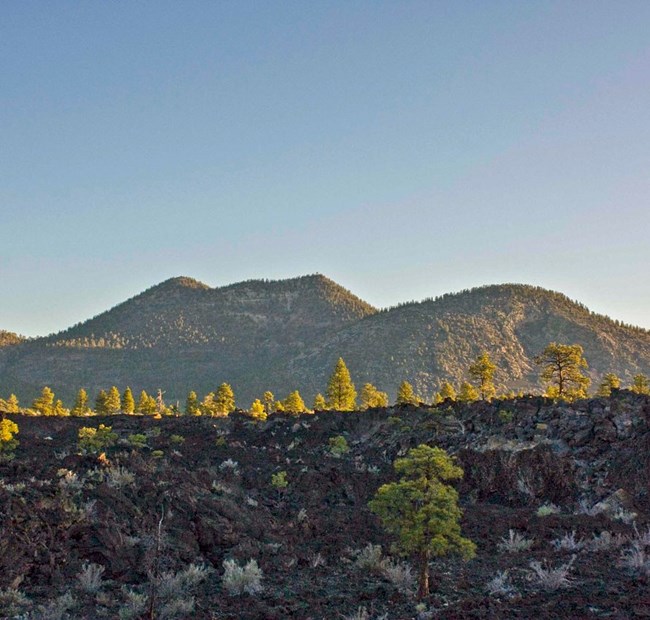Last updated: January 17, 2025
Article
NPS Geodiversity Atlas—Sunset Crater Volcano National Monument, Arizona
Geodiversity refers to the full variety of natural geologic (rocks, minerals, sediments, fossils, landforms, and physical processes), soil resources, and processes that occur in the park. A product of the Geologic Resources Inventory, the NPS Geodiversity Atlas delivers information in support of education, Geoconservation, and integrated management of living (biotic) and non-living (abiotic) components of the ecosystem.
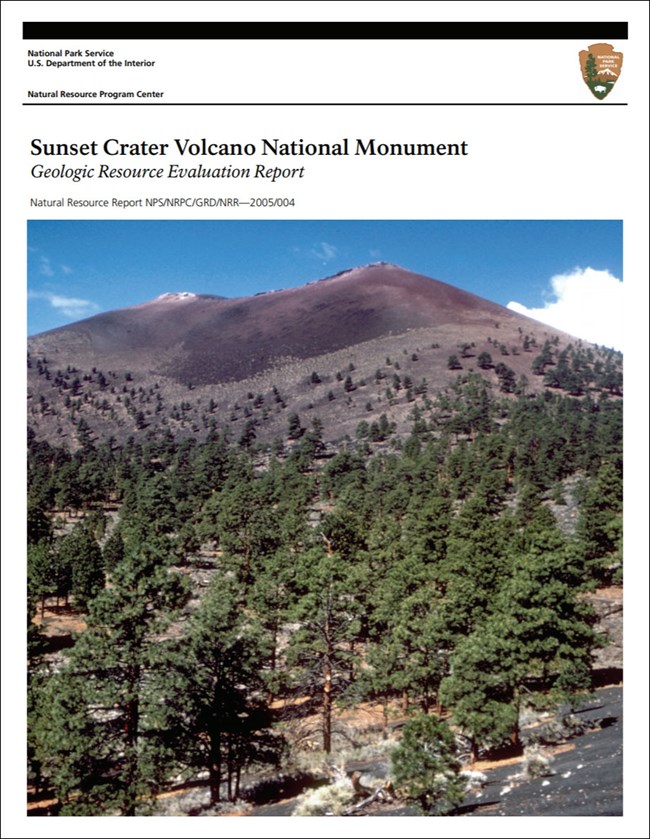
Introduction
Sunset Crater Volcano National Monument preserves the 1,000-ft (300-m) Sunset Crater cinder cone—one of the best examples of this type of volcano on the continent. Sunset Crater was built through an especially vigorous eruption for a cinder cone, producing an eruption column 65,000 feet (12 mi, 20 km) in height that deposited ash over 270 square miles (700 square km).
Together, the Sunset Crater cinder cone and associated lava flows and volcanic features make up a stunning volcanic landscape on the southern edge of the Colorado Plateau.
Geologic Significance & Geodiversity Highlights
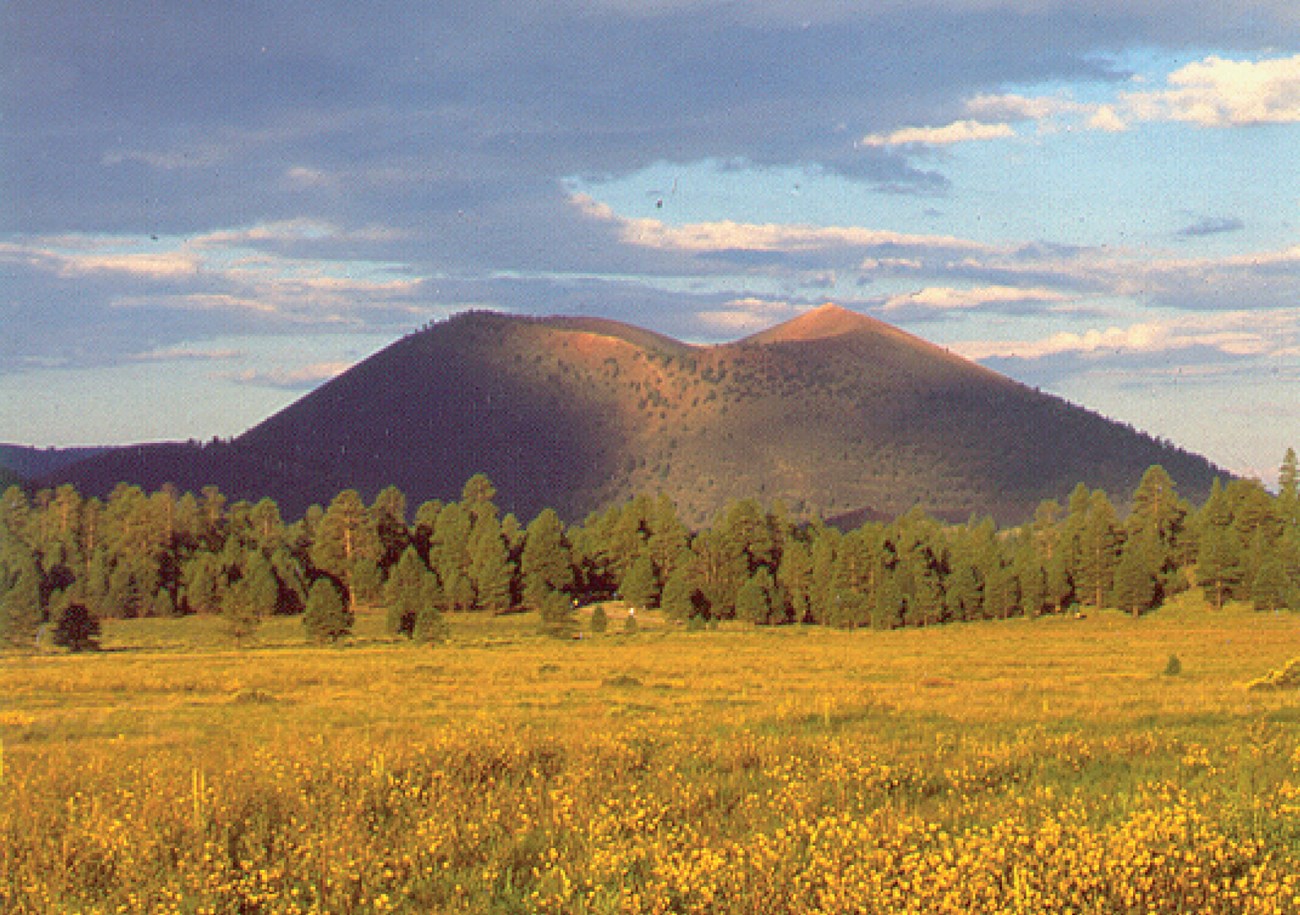
Photo courtesy of Robert J. Lillie.
Geologic Significance & Geodiversity Highlights
Sunset Crater Volcano is an exceptionally large and picturesque cinder cone located near the San Francisco Peaks in the ponderosa pine forest of northern Arizona near Flagstaff.
Its eruption nearly 1,000 years ago in 1085 CE (common era) was the most recent volcanic activity in the San Francisco Volcanic Field. The eruption likely lasted less than a year and had a great impact on prehistoric people living in the area. Lava erupted from the volcano only covered a relatively small area (approximately 3 square miles or 8 square km), but significant ash deposits accumulated much further away, including at places such as in Wupatki National Monument, which is about 12-15 miles (20-25 km) away. Ash deposits deeper than about 6-8 inches (15-20 cm) are not suitable for agriculture, resulting in the abandonment of many areas that had been previously used for growing food. The eruption column was so tall that it may have been observed by people living throughout much of the southwest.
Sunset Crater gets its moniker from a description of the cone by John Wesley Powell, who was probably the first geologist to see it. Powell led the first exploration of the Colorado River through Grand Canyon in 1869 and observed the cone during later geologic studies in the region. His description of the volcano still captures its essence:
A portion of the cone is of bright reddish cinders, while the adjacent rocks are of black basalt. The contrast in the colors is so great that on viewing the mountain from a distance the red cinders seem to be on fire. From this circumstance the cone has been named Sunset Peak. When distant from it ten or twenty miles it is hard to believe that the effect is produced by contrasting colors, for the peak seems to glow with a light of its own.
The red cinders at the top of the cone are a result of oxidation that took place near fumaroles (vents or openings at the surface where volcanic gases and vapors are emitted) located near the main vent in the summit crater.
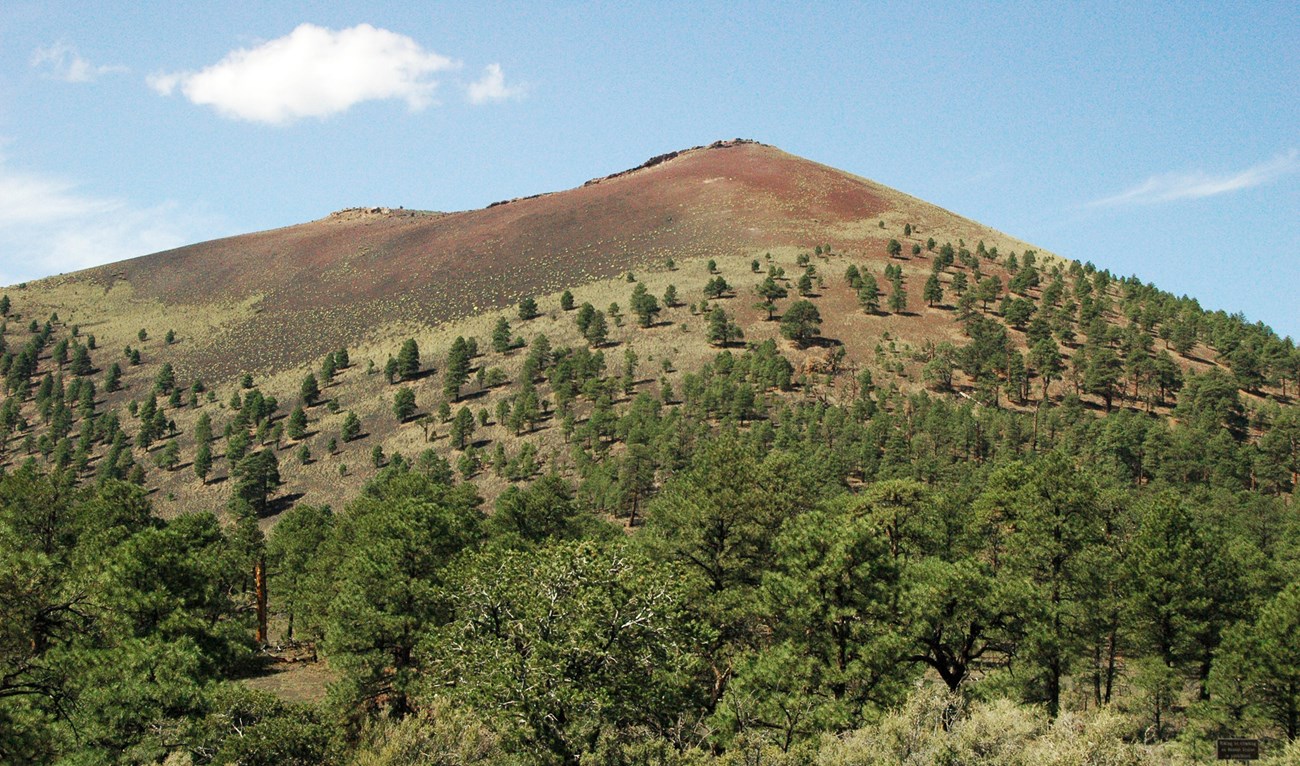
James St. John photo.
Learn More
-
Sunset Crater Volcano National Monument is one of 19 units of the National Park System set aside primarily for their volcanic resources. See also, NPS—Primary Volcanic Parks.
-
Sunset Crater Volcano National Monument is one of 33 units of the National Park System containing a volcano. See also, NPS—Volcano Types in Parks.
-
Sunset Crater Volcano National Monument is one of 17 units of the National Park System containing a volcano that experienced a historic or prehistoric eruption. Sunset Crater erupted in 1085 CE. See also, NPS—Prehistoric and Historic Eruptions.
Geologic Setting
Sunset Crater is located near the center of the San Francisco Volcanic Field near the southern margin of the Colorado Plateau. The Colorado Plateau has an overall high elevation, thick continental crust, and relatively little structural deformation so that mostly flat-lying sedimentary rocks are exposed at the surface. The arid to semiarid environment as well as the immense erosional power of the Colorado River and its tributaries has led to excellent exposures of thick sedimentary sequences in places like Grand Canyon National Park, Glen Canyon National Recreation Area, and Canyonlands National Park.
The San Francisco Volcanic Field is one of several monogenetic volcanic fields located on the margin of the Colorado Plateau. Monogenetic volcanic fields are clusters of volcanoes that mostly consist of cinder cones, fissure volcanoes, and other volcanoes that each individually erupt only once. They form in areas with low magma supply.
Other monogenetic volcanic fields also located near the boundary of the Colorado Plateau include the Kolob Volcanic Field in and around Zion National Park, the Uinkaret Volcanic Field of Grand Canyon National Park and Grand Canyon-Parashant National Monument, the Hopi Buttes Volcanic Field that is partially within Petrified Forest National Park, and the Zuni-Bandera Volcanic Field in and around El Malpais National Monument in New Mexico. See also, NPS—Monogenetic Volcanic Fields
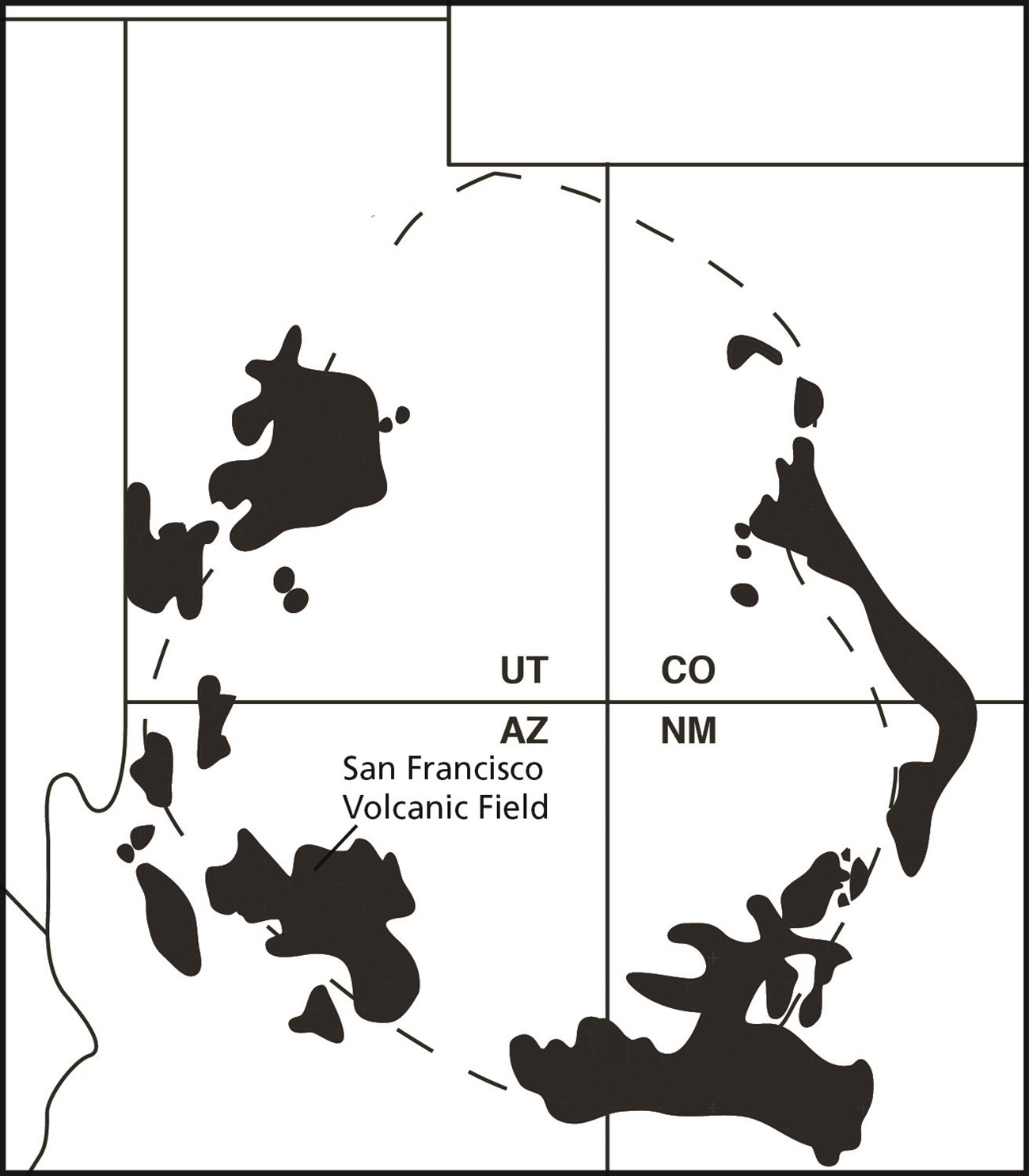
Modified from David Loope, Richard Kettler, Kendra Murray, Joel Pederson, Peter Reiners, 2016. "Sandstones & Utah’s canyon country: Deposition, diagenesis, exhumation, and landscape evolution", Stephen M. Keller, Matthew L. Morgan.
San Francisco Volcanic Field


Left image
The San Francisco Volcanic Field covers about 1,800 square miles (4,660 square km and includes the state’s tallest mountain, Humphreys Peak, a composite volcano, at an elevation of 12,633 feet (3,850 m).
Credit: USGS image.
Right image
Image with feature labels added.
The San Francisco Volcanic Field first became active about 6 million years ago, and the eruption of Sunset Crater Volcano nearly 1,000 years ago was the most recent in the field. This volcanic field contains approximately 600 volcanoes and covers about 1,800 square miles (4,700 square km).
Most of the volcanoes in the field are cinder cones and their associated basaltic lava flows. A number of lava domes are also found in the field and a large composite volcano (San Francisco Mountain) is located near the center. The San Francisco Peaks, including Humphreys Peak, which is the tallest mountain located in Arizona at 12,633 feet (3,851 m), are the eroded remnants of San Francisco Mountain which may have undergone a flank collapse like the one that truncated Mount St. Helens in 1980.
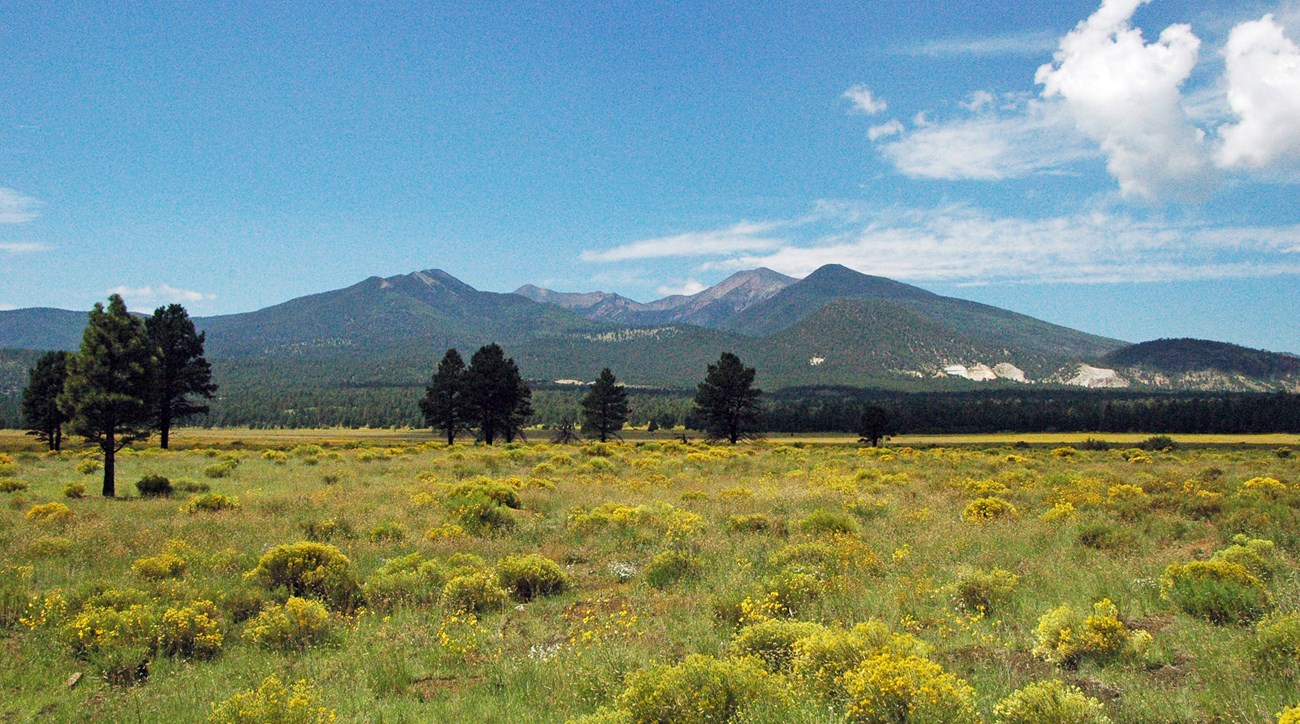
James St. John photo.
Volcanic activity in the San Francisco Volcanic Field has migrated from the west to the east. Any future eruptions in the field may occur near Sunset Crater Volcano or further to the east.
Related Links
- USGS—A Geologic Field Guide to S P Mountain and its Lava Flow, San Francisco Volcanic Field, Arizona
Geologic History and Eruption Overview
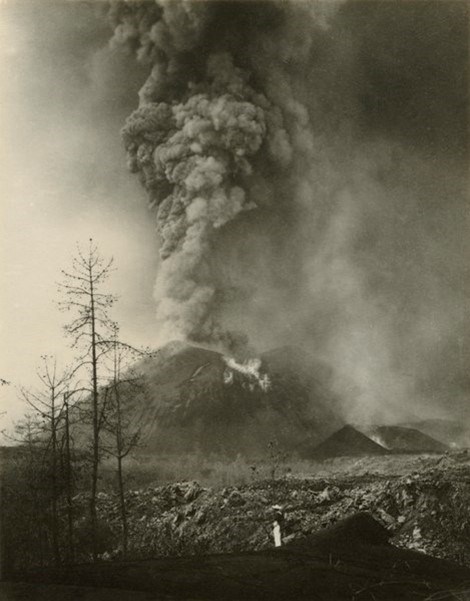
Photo by Bodil Christensen, public domain.
Cinder cones like Sunset Crater Volcano are monogenetic, meaning that they typically have one period of volcanic activity. Prior to the eruption of Sunset Crater Volcano, there were other cinder cones in the surrounding San Francisco Volcanic Field, including the nearby Lenox Crater along the southern boundary of the monument. But no pre-existing volcanic edifice was present where Sunset Crater ultimately formed.
Cinder cone eruptions frequently begin along an eruptive fissure and then become centralized around a single vent. Lava flows may be emitted from vents at the base of the cinder cone, particularly during the waning stages of the eruption. Cinder cone eruptions typically last a short period of time (from months to a few years). They are usually mildly explosive and at a 1 (Severe) or 2 (Explosive) on the Volcanic Explosivity Index, with a Strombolian eruption style that looks like volcanic fireworks.
The eruption of Sunset Crater Volcano was typical of that for a cinder cone in many ways. But it was substantially more explosive than other cinder cone eruptions and is the most explosive eruption of a cinder cone that has been documented.
Sunset Crater Volcano’s eruption was Sub-Plinian with a VEI of 4 (Cataclysmic). Sub-Plinian eruptions create unsteady but sustained eruption columns that are usually less than 12 miles (20 km) in height. Sunset Crater’s extremely explosive eruption was propelled by unusually high concentrations of CO2 in the magma. Rapid exsolution of this gas created a bubbly magma that in turn propelled an unusually rapid ascent to the surface.
The eruption of Sunset Crater was also a large volume event for a cinder cone, with a volume of 0.12 cubic miles (0.5 km3) dense rock equivalent (DRE).
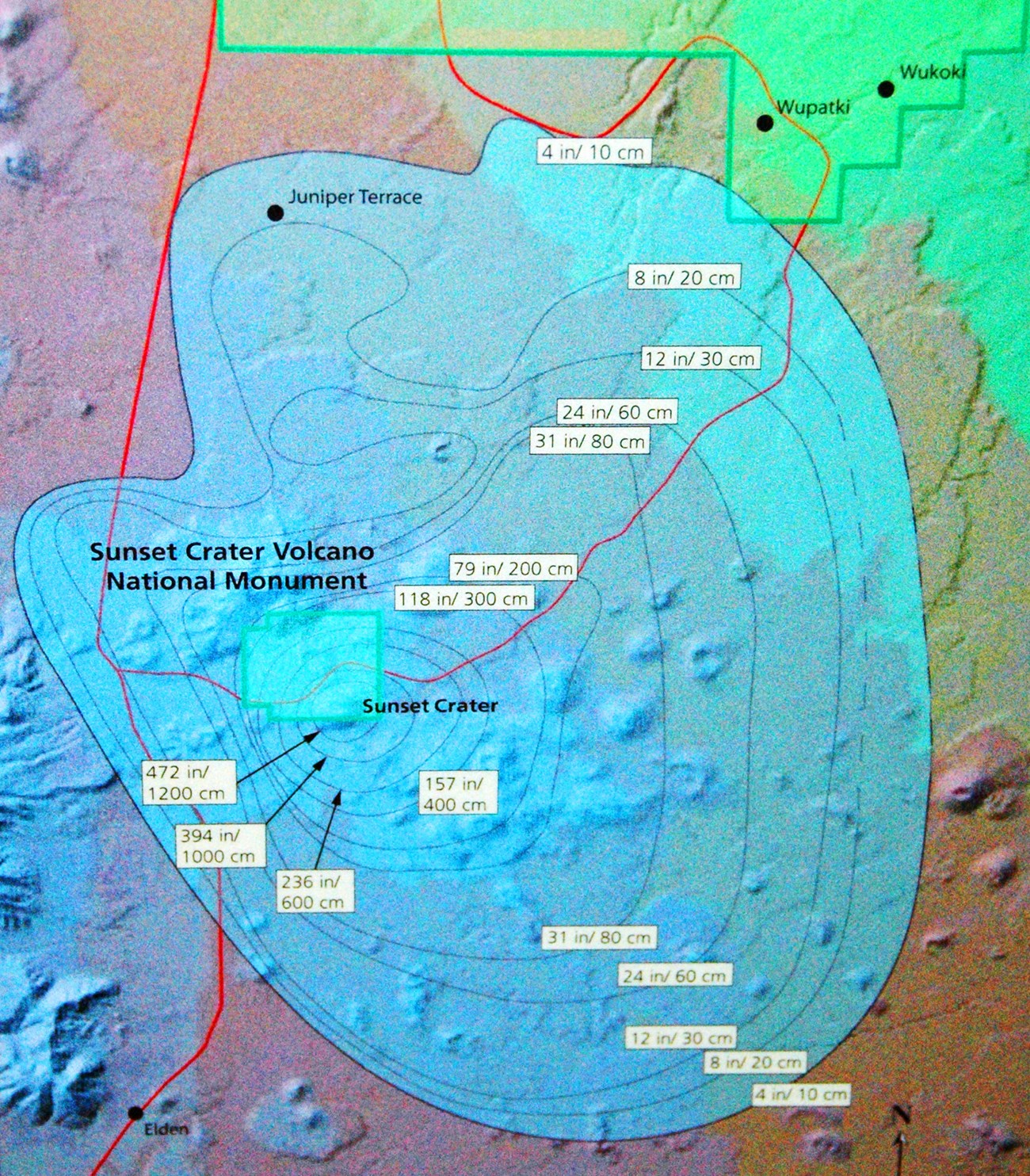
Photo by James St. John.
Related Links
Eruption of Sunset Crater Volcano

Photo courtesy of Allyson Mathis.
Sunset Crater eruption consisted of three phases:
Phase 1: Fissure eruption that produced low fire fountains and a small lava flow. The 6-mile (10-km) long fissure was oriented northwest-southeast. Sunset Crater Volcano is located near the northwestern terminus of this fissure.
Phase 2: The highly explosive eruption that produced the Sunset Crater Volcano cinder cone. Eruption of the Kana’a and Bonita lava flows also took place during this phase.
Phase 3: The final waning stage of the cinder cone eruption that was not as explosive as the main Sub-Plinian event. This stage produced a much smaller volume of tephra and the continued eruption of the Bonito lava flow.
The Age of Sunset Crater Volcano
Based on tree-ring dating (dendrochronology) and chemical analysis of tree rings (dendrochemistry), Sunset Crater Volcano erupted in 1085 CE.
A slightly older, and widely reported age, for the eruption of Sunset Crater of 1064 CE was based on tree-ring dating on wood beams from a prehistoric structure at Wupatki National Monument. These wood samples show an abrupt narrowing of tree rings that were interpreted to be the result of the suppression in tree growth caused by eruption impacts.
However, narrow tree rings can be caused by factors other than volcanic eruptions. Dendrochemistry allows scientists to look for chemical changes in suppressed tree rings that may be specifically tied to volcanic eruptions. Researchers studied Cinder Cone in Lassen Volcanic National Park which erupted in 1666 CE and Paricutin Volcano in Mexico that began erupting in 1943 and found that phosphorus content in wood may abruptly increase with a volcanic eruption and that there may also be a decrease in the isotopic ratio of the element strontium. Samples from Wupatki wood beams that are between 1085 and 1090 CE show both these chemical signatures.
Geologic Features and Processes
Sunset Crater Cinder Cone
Sunset Crater Volcano is much larger than most cinder cones. Cinder cone volcanoes are typically a few hundred feet tall (100 to 150 m), and rarely are larger than 600 to 900 feet (200 to 300 m) in height. Sunset Crater stands approximately 1,000-ft- (300-m)-tall, reaching an elevation of 8,042 feet (2,451 m). It has a diameter of approximately 1 mile (1,600 m) with a crater approximately 350 feet (107 m) deep.
Like all cinder cones, Sunset Crater consists of an accumulation of volcanic cinders (scoria) and ash accumulated around a central vent. Its steep slopes average approximately 30 degrees, close to the angle of repose for volcanic cinders.
Because cinder cones consist mostly of unconsolidated ash and cinders, they are very vulnerable to erosion due to disturbances such as foot traffic. Because of the damage that hiking was causing on the Sunset Crater cinder cone, it has been closed to hiking since 1973.
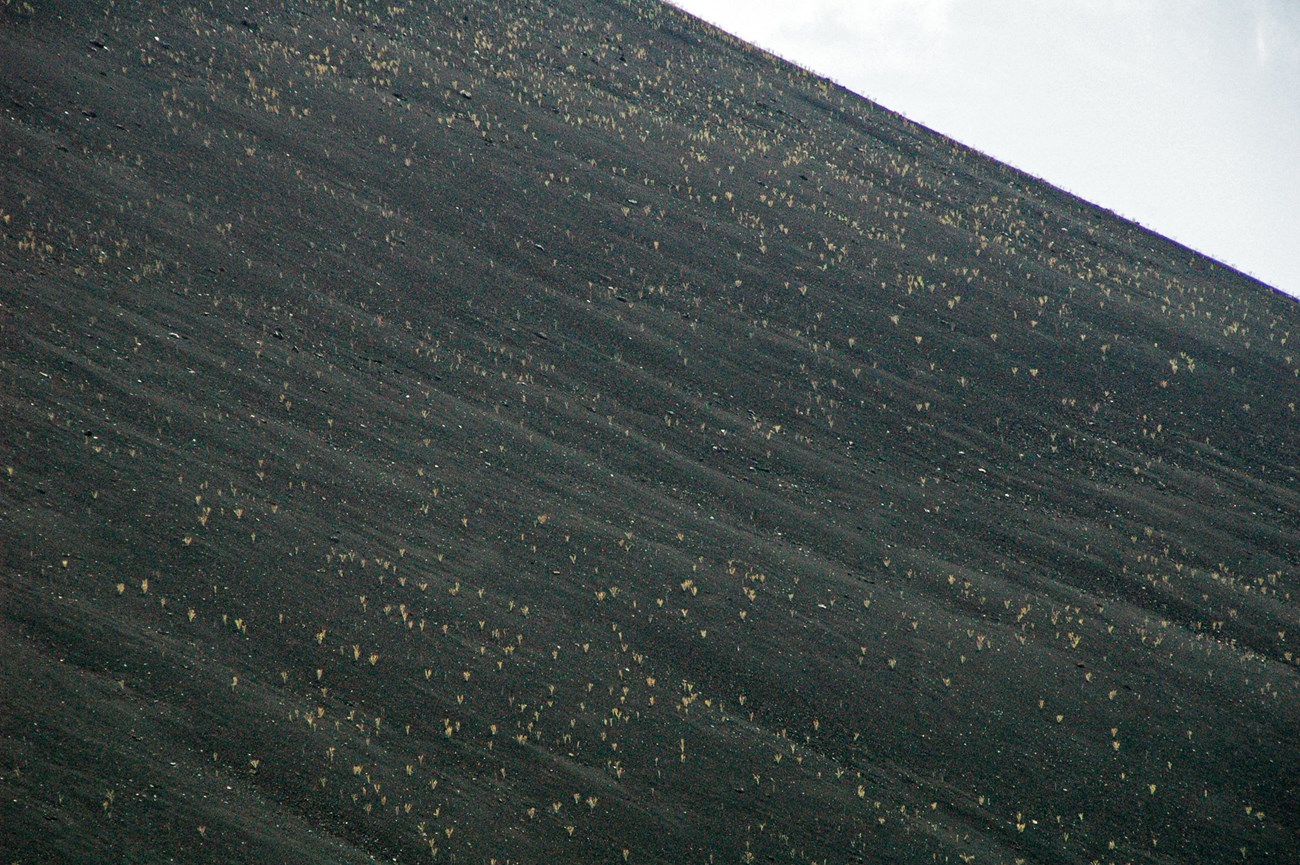
James St. John photo.
Related Links
Lava Flows

Photo by Allyson Mathis.
Two main lava flows were erupted from the base of Sunset Crater Volcano. The Kana’a flow was emitted from the eastern side of the cone and traveled to the northeast and the Bonita lava flow was emitted from the western flank and traveled towards the northwest.
Both flows consist of ropy lava (pāhoehoe) near the vent and rough, clinkery lava (‘a‘ā) further away. Segments of lava tubes which are mostly collapsed are also present on both flows.
Several trails in Sunset Crater Volcano National Monument allow visitors to observe features of the Bonito lava flow. The Lava Flow Trail travels across a section where pāhoehoe surfaces are present along with features such as squeeze ups, a lava tube, hornitos, and pieces of the Sunset Crater cinder cone that were rafted away from the main cone by flowing lava during the eruption. The ‘A‘ā Trail allows observation of the rougher lava further away from the vent. The Lava’s Edge Trail traverses near the Bonito’s flow front.

Photo by Allyson Mathis.
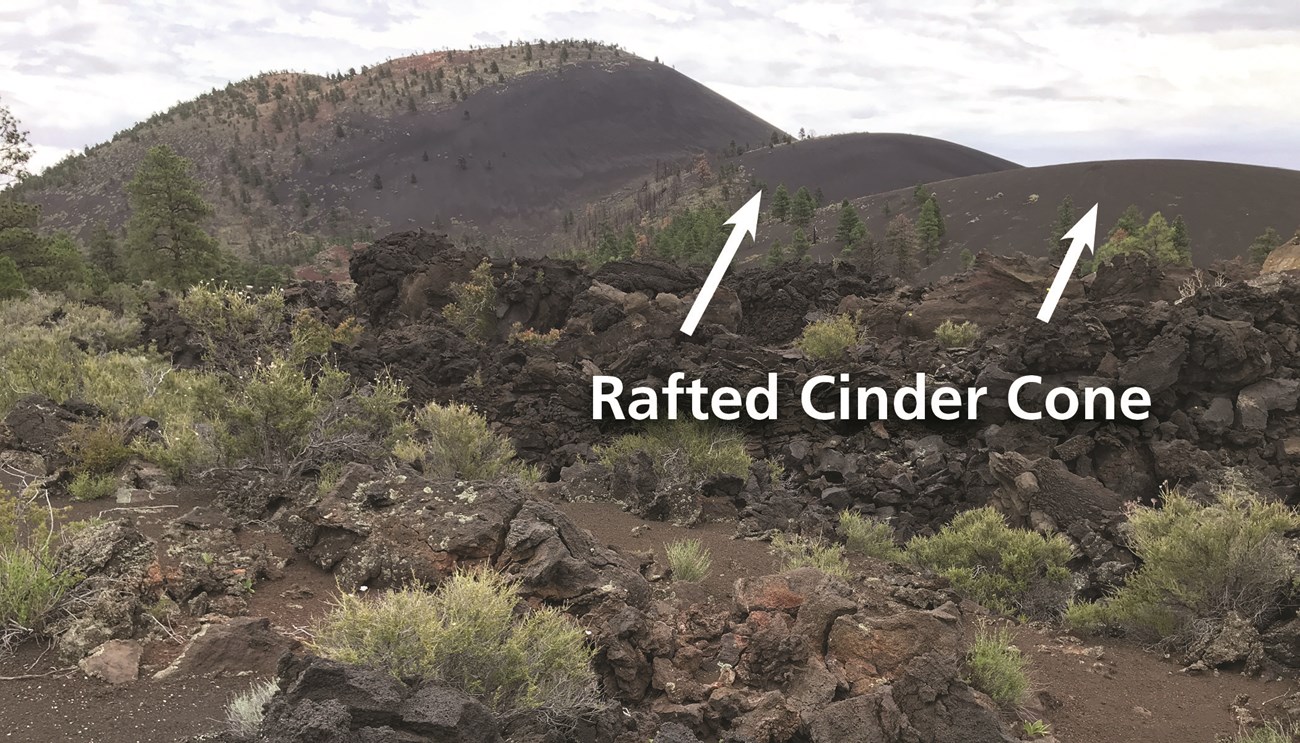
Photo by Allyson Mathis.
Related Links
Caves and Karst

Photo by Allyson Mathis.
Volcanic landscapes where lava flows are present are considered a type of pseudokarst. Pseudokarst is formed through geological processes that do not involve dissolution of rock, which occurs in true karst. The lava tubes and collapsed tubes in Sunset Crater National Monument are volcanic pseudokarstic. Based on the presence of volcanic bedrock, 100% of Sunset Crater National Monument was identified as containing pseudokarst.
All NPS cave resources are protected under the Federal Cave Resources Protection Act of 1988 (FCRPA)(16 U.S.C. § 4301 et seq.).
Related Links
Geodiversity Values
Sunset Crater Volcano National Monument was established because of the scientific and public interest of the geologic formations in the monument, all of which are volcanic in origin. The monument contains the Sunset Crater cinder cone and associated lava flows and areas covered by cinders deposited during its eruption. It also contains parts of four other older and smaller cinder cones, including Lennox Crater. The geoheritage values of the monument, including its geodiversity, all tie back to its volcanic resources and processes that formed them, especially the 1085 CE eruption that built Sunset Crater Volcano.
Geodiversity highlights of Sunset Crater Volcano National Monument include:
-
The traditional knowledge of Sunset Crater’s eruption and its impact on prehistoric people living in its vicinity;
-
The inverted topography and volcanic geomorphology of the San Francisco Volcanic Field;
-
Endemic wildflowers that grow on the cinder deposits;
- The use of an area near Sunset Crater Volcano for Apollo astronaut training.
Traditional Knowledge of Sunset Crater Volcano’s Eruption

Photo by Helga Teiwes courtesy of Desert Archaeology, Inc.
Volcanic eruptions have both short-term and long-term impacts on the people living nearby. The eruption of Sunset Crater Volcano presented a variety of hazards to the Sinagua (ancestral Puebloan) people living around the volcano, and caused them to make several adaptations to the events.
People living very close to the volcano probably had to abandon their agricultural fields and move further away to escape the impacts of fallout of volcanic ash and cinders. Areas close to the volcano with thick ashfall deposits became unsuitable for agriculture, but areas further away where the ashfall layers were thin experienced an increase in productivity because the ash served as a mulch that helped retain soil moisture.
Impressions of corn cobs and stalks in pieces of basalt recovered from an archeological site near Sunset Crater indicate that people interacted with active volcanic features during the eruption, perhaps in a ritualistic manner. The characteristics of these “cornrocks” suggest that they resulted from the placement of corn around an active hornito. The pieces of cornrock were then carried to the site of the pithouse where they were recovered during archeological excavation.
Related Links
Volcanic Inverted Topography and Volcanic Geomorphology
The San Francisco Volcanic Field surrounding Sunset Crater Volcano National Monument provides classic examples of volcanic inverted topography and is a natural laboratory where people can observe the impact of erosion on young volcanic landscapes.
The steep slopes and nearly textbook form of Sunset Crater itself reveal its young age as they show few signs of erosion. Cinder cones degrade with age due to hillslope processes that move cinders and ash deposits downhill. As a result, older cinder cones become more rounded and not as tall. The older cinder cones near Sunset Crater show gradations in how much they have been eroded depending on their age.
Inverted topography develops because basaltic lava flows are usually more resistant to erosion than other rock types. Lava flows travel down valleys and fill topographic lows at the time of eruption, however through time they may become perched above the general level of the land due to differential erosion so that what had been valley flows become topographic highs.
Related Links
Rare Plants
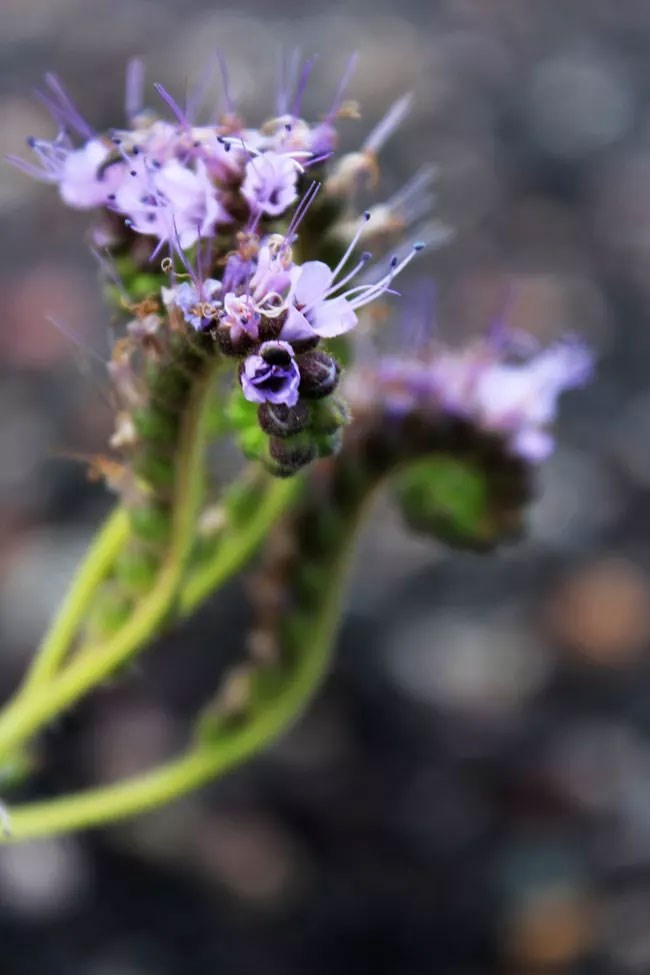
C. Griffing.
Two rare plants that only grow on young volcanic cinder deposits are found in Sunset Crater National Monument. Both are US Fish and Wildlife Service species of concern.
Sunset Crater penstemon (Penstemon clutei) is only found in the northeastern part of the San Francisco Volcanic Field, including in, and around the national monument.
Cinders phacelia (Phacelia serrata) is only found in two areas: in the San Francisco Volcanic Field in, and near Sunset Crater National Monument and in El Malpais National Monument in New Mexico.
Related Links
Apollo Astronaut Training
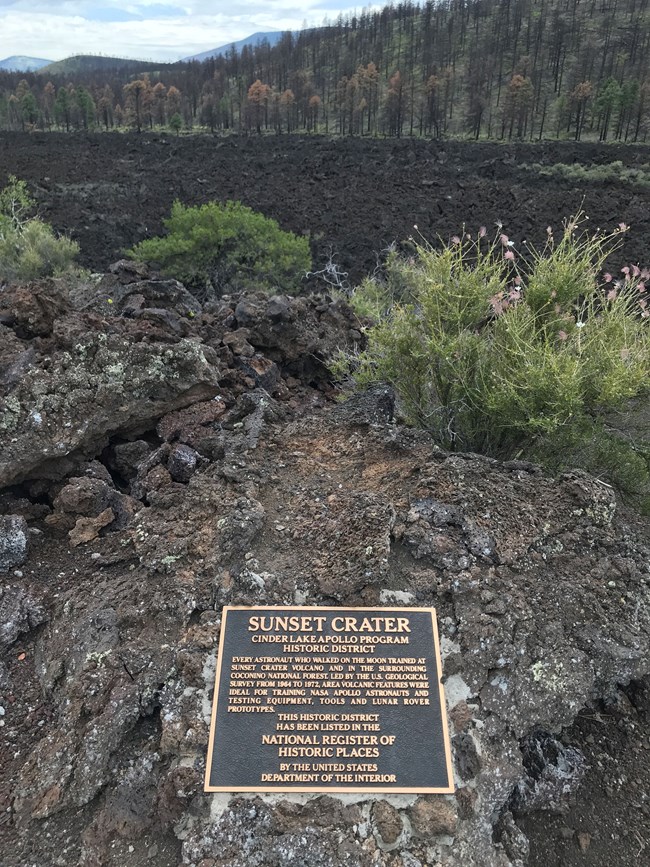
Photo by Allyson Mathis.
The Cinder Lake crater field located just south of Sunset Crater Volcano National Monument was used for Apollo Astronaut training in the 1960s and 1970s. The field was constructed in an area covered by volcaniclastic material ejected during the Sunset Crater eruption and blasted with explosives to create craters to replicate the lunar surface.
Geohazards
Volcanic Hazards
Although Sunset Crater Volcano should not erupt again as cinder cones generally have only one period of volcanic activity, an eruption may take place elsewhere in the San Francisco Volcanic Field. Monogenetic volcanic fields have low magma supply rates so there may be long intervals between subsequent eruptions.
In 2022, a group of scientists from 40 different organizations, including the US Geological Survey, took part in a month-long role-playing scenario about a hypothetical future eruption in the San Francisco Volcanic Field. Researchers modeled the actions they would take to monitor magma rise towards the surface prior to an eruption and how scientists and land managers would monitor hazards and protect public safety during an eruption event. The San Francisco Volcanic Field was chosen because of its proximity to Flagstaff and the fact that its most recent activity was geologically very recent.
The US Geologic Survey’s 2018 update to the national volcanic threat assessment places the San Francisco Volcanic Field into the moderate threat category, which is in mid-range in five threat categories. The threat assessment is not a forecast of future eruption, but an evaluation of the potential severity of impacts that may result from future eruptions at a given volcano. The assessment for the San Francisco Volcanic Field is based on Sunset Crater’s eruption.
The assessment consists of two parts: an evaluation of volcanic hazards and the exposure of people and human infrastructure to those hazards. The volcanic hazard threat of the San Francisco Volcanic Field is relative low, but the exposure of people is relatively high, including aviation exposure, leading to an overall threat score of 50.6. Sunset Crater is one of 17 units of the National Park System containing volcanoes evaluated in the USGS threat assessment report.
Related Links
Seismic Hazards
The San Francisco Volcanic Field is located within the Northern Arizona Seismic Belt. The Northern Arizona Seismic Belt is part of the Intermountain Seismic Belt extending from Idaho south into Arizona and is located along the Basin and Range-Colorado Plateau transition zone.
Sunset Crater Volcano National Monument is classified as a moderate seismic hazard. The USGS 2014 Seismic Hazard Map indicates that the area has a 2% chance that earthquake peak ground acceleration of between 14 and 16 %g (percent of gravity) of being exceeded in 50 years. This peak ground acceleration is roughly equivalent to VI on the Modified Mercalli Intensity Scale. The expected number of damaging earthquakes shaking in north-central Arizona in 10,000 years is between 10 and 20.
Related Links
Maps and Reports
- Scoping summaries are records of scoping meetings where NPS staff and local geologists determined the park’s geologic mapping plan and what content should be included in the report.
- Digital geologic maps include files for viewing in GIS software, a guide to using the data, and a document with ancillary map information. Newer products also include data viewable in Google Earth and online map services.
- Reports use the maps to discuss the park’s setting and significance, notable geologic features and processes, geologic resource management issues, and geologic history.
- Posters are a static view of the GIS data in PDF format. Newer posters include aerial imagery or shaded relief and other park information. They are also included with the reports.
- Projects list basic information about the program and all products available for a park.
Source: NPS DataStore Saved Search 3177. To search for additional information, visit the NPS DataStore.
A NPS Soil Resources Inventory project has been completed for Sunset Crater Volcano National Monument and can be found on the NPS Data Store.
Source: NPS DataStore Saved Search 3128. To search for additional information, visit the NPS DataStore.
Related Articles
Sunset Crater Volcano National MonumentNational Park Service Geodiversity Atlas
The servicewide Geodiversity Atlas provides information on geoheritage and geodiversity resources and values within the National Park System. This information supports science-based geoconservation and interpretation in the NPS, as well as STEM education in schools, museums, and field camps. The NPS Geologic Resources Division and many parks work with National and International geoconservation communities to ensure that NPS abiotic resources are managed using the highest standards and best practices available.

